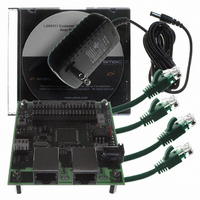EVB9311 SMSC, EVB9311 Datasheet - Page 158

EVB9311
Manufacturer Part Number
EVB9311
Description
EVALUATION BOARD LAN9311-NU
Manufacturer
SMSC
Series
0133r
Datasheet
1.LAN9311-NU.pdf
(460 pages)
Specifications of EVB9311
Main Purpose
Interface, Ethernet
Embedded
No
Utilized Ic / Part
LAN9311
Primary Attributes
2 Ports, 100BASE-TX/10BASE-T, Managed
Secondary Attributes
2 PHYs with HP Auto-MDIX, Auto- Flow Control, 32-bit CRC, MDI/MDI-X
Lead Free Status / RoHS Status
Lead free / RoHS Compliant
Other names
638-1076
- Current page: 158 of 460
- Download datasheet (5Mb)
Revision 1.7 (06-29-10)
11.2.1
Clock synchronization and hardware processing between the network data and the time stamp capture
hardware causes the time stamp point to be slightly delayed. The host software can account for this
delay, as it is fairly deterministic.
mode of operation. Refer to
Once the packet type is matched, according to
verified, the following occurs:
Note: Packets that do not contain an integral number of octets are not considered valid and do not
Capture Locking
The corresponding ports’ clock capture, sequence ID, and source UUID registers can be optionally
locked when a capture event occurs, preventing them from being overwritten until the host clears the
corresponding interrupt flag in the
This is accomplished by setting the corresponding lock enable bit(s) in the
(1588_CONFIG). Each port has two lock enable control bits within this register, which allow the receive
and transmit portions of each port to be locked independently. In addition, a lock enable bit is provided
for each time stamp enabled GPIO (LOCK_ENABLE_GPIO_8 and LOCK_ENABLE_GPIO_9) which
prevents the corresponding GPIO clock capture registers from being overwritten when the GPIO
interrupt in
14.2.5.22, "1588 Configuration Register (1588_CONFIG)," on page 223
the capture locking related bits.
MODE OF OPERATION
The time stamp is loaded into the corresponding ports’ capture registers:
The Sequence ID and Source UUID are loaded into the corresponding ports’ registers:
The corresponding maskable interrupt flag is set in the
(1588_INT_STS_EN). (Refer to
on IEEE 1588 interrupts.)
–On Reception:
–On Transmission:
–On Reception:
–On Transmission:
(1588_CLOCK_HI_RX_CAPTURE_x)
Register (1588_CLOCK_LO_RX_CAPTURE_x)
(1588_CLOCK_HI_TX_CAPTURE_x)
Register (1588_CLOCK_LO_TX_CAPTURE_x)
(1588_SEQ_ID_SRC_UUID_HI_RX_CAPTURE_x)
DWORD Receive Capture Register (1588_SRC_UUID_LO_RX_CAPTURE_x)
Register (1588_SEQ_ID_SRC_UUID_HI_TX_CAPTURE_x)
Low-DWORD Transmit Capture Register (1588_SRC_UUID_LO_TX_CAPTURE_x)
cause a capture.
100 Mbps
10 Mbps
1588 Interrupt Status and Enable Register (1588_INT_STS_EN)
Port x 1588 Clock High-DWORD Receive Capture Register
Port x 1588 Sequence ID, Source UUID High-WORD Receive Capture Register
Port x 1588 Clock High-DWORD Transmit Capture Register
Port x 1588 Sequence ID, Source UUID High-WORD Transmit Capture
Table 11.2 Time Stamp Capture Delay
Chapter 7, "Ethernet PHYs," on page 82
Table 11.2
1588 Interrupt Status and Enable Register
DATASHEET
Section 11.6, "IEEE 1588 Interrupts," on page 161
158
Two Port 10/100 Managed Ethernet Switch with 16-Bit Non-PCI CPU Interface
details the time stamp capture delay as a function of the
and
and
Table
Port x 1588 Clock Low-DWORD Transmit Capture
Port x 1588 Clock Low-DWORD Receive Capture
11.1, and the Frame Check Sequence (FCS) is
and
1588 Interrupt Status and Enable Register
Port x 1588 Source UUID Low-
DELAY (+/- 10 nS)
and
120 nS
30 nS
for details on these modes.
Port x 1588 Source UUID
for additional information on
1588 Configuration Register
(1588_INT_STS_EN).
is set. Refer to
SMSC LAN9311/LAN9311i
for information
Datasheet
Section
Related parts for EVB9311
Image
Part Number
Description
Manufacturer
Datasheet
Request
R

Part Number:
Description:
FAST ETHERNET PHYSICAL LAYER DEVICE
Manufacturer:
SMSC Corporation
Datasheet:

Part Number:
Description:
357-036-542-201 CARDEDGE 36POS DL .156 BLK LOPRO
Manufacturer:
SMSC Corporation
Datasheet:

Part Number:
Description:
357-036-542-201 CARDEDGE 36POS DL .156 BLK LOPRO
Manufacturer:
SMSC Corporation
Datasheet:

Part Number:
Description:
357-036-542-201 CARDEDGE 36POS DL .156 BLK LOPRO
Manufacturer:
SMSC Corporation
Datasheet:

Part Number:
Description:
4-PORT USB2.0 HUB CONTROLLER
Manufacturer:
SMSC Corporation
Datasheet:

Part Number:
Description:
Manufacturer:
SMSC Corporation
Datasheet:

Part Number:
Description:
Manufacturer:
SMSC Corporation
Datasheet:

Part Number:
Description:
FDC37C672ENHANCED SUPER I/O CONTROLLER WITH FAST IR
Manufacturer:
SMSC Corporation
Datasheet:

Part Number:
Description:
COM90C66LJPARCNET Controller/Transceiver with AT Interface and On-Chip RAM
Manufacturer:
SMSC Corporation
Datasheet:

Part Number:
Description:
Manufacturer:
SMSC Corporation
Datasheet:

Part Number:
Description:
Manufacturer:
SMSC Corporation
Datasheet:

Part Number:
Description:
Manufacturer:
SMSC Corporation
Datasheet:

Part Number:
Description:
Manufacturer:
SMSC Corporation
Datasheet:











